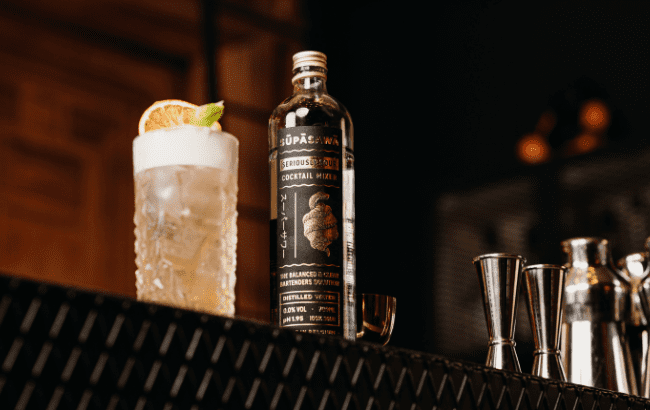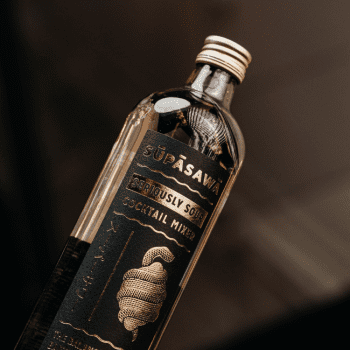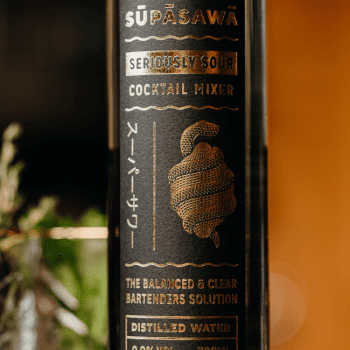Supasawa on mixer innovation: ‘you need to go 200% in’
By Rupert HohwielerThe company behind ‘first-to-market’ sour mixer Supasawa on how innovation in the category is key to attracting younger drinkers.

Made with distilled water and five acids to replicate a sour flavour profile (malic, tartaric, succinic, citric, phosphoric), Supasawa cuts the need for freshly-squeezed lemons or lime in the cocktail making process.
The premium sour mixer was launched in 2018 by Deluxe Distillery in Belgium as a smart solution for bartenders. Fast forward to today and its shortcuts are proving popular in a bar scene facing rising costs and challenges in finding staff.
Speaking to The Spirits Business about how mixer brands need to be clever in the current operating environment, CEO and owner Guillaume Lambrecht explained: “You don’t want to waste the wages and time of bartenders by squeezing lemons and limes for four hours a day, especially if you only have a handful of customers in the day.
“You can have two litres of lemon juice leftover and it’s all going into the gutter, not just the juice, but your time and then your wages. Bars are already almost drowning into their bills and electricity costs, water, and everything around it.”
On its website, Supasawa lists things like saving 35 citrus fruits and 15 minutes of juicing time per bottle, among its perks.
When it came out, Lambrecht says he didn’t fully know there was a gap in the market: “People were knocking on our doors and saying ‘we need it right now, like really right now’. We said okay and then it started to flow out of Belgium and to the UK – and now we’re in 55 countries worldwide.
First to market
Supasawa claims to be the first to market for a product of its kind and Lambrecht notes that the brand “could work with everybody because nobody had something like us in their portfolio. The guys from Campari and others loved to use it in certain Spritzes or tonics or Highballs, or whatever, and we’re a little bit, how might I say… like a ‘blue ocean’.”

Explaining this, he continues: “a ‘blue ocean’ in the sense that we can just swim around without somebody disturbing us. Of course there are some small competitors who are trying to compete with us, in the US, or in other countries. Competition is good – we were the first one. We have already been on the market for seven years. And it’s a bit of an ambition to create a memo that reads: ‘okay, the sour mixer is just Supasawa’.
“For somebody else to come over and say ‘oh, I have a sour mixer, it’s something like Supasawa. So almost a category on its own – that’s the ambition.”
While Supasawa has taken off at the bar, it’s also tracking well with consumers at home, Lambrecht says. Of Supasawa’s relevance here, he details: “That whole category is what, 10,000 times bigger than just the bartender and our industry, right?
“In a certain way, we strongly believe that brands are being built from the industry itself, which spread from bartenders to the people at home. We see a huge change in the last one to two years in that. For example, the UK is one our strongest markets, and because of being one of our strongest markets throughout the years, we have been implemented a lot into older online stores like Master of Malt and Whisky Exchange, and through their business-to-consumer (B2C) platform, where there is a lot of traction on Supasawa.”
Why? He says: “We believe bartenders are talking about Supasawa to the consumer who is drinking the cocktails, tasting their cocktails and then buying our product for their home.
“What is the only thing that we all miss when making cocktails at home? It’s lemon and lime. So if you want to make a Margarita or just a simple Moscow Mule, it’s always ‘we don’t have those’, but with Supasawa, if you have one bowl, you can make 30-35 cocktails (more or less) at home.
Playing to new generations
When asked about health trends and ‘cleaner’ tonics and sodas entering the mixer space, Lambrecht contends the focus for the brand is still on being easy and cost-effective to use. Supasawa isn’t more ’healthy’ than real lemon or lime juice, it just negates the need for them from the cocktail process.
He adds: ”The health item that’s burning today – with the non-alcoholic part and everything around it – it can sometimes be a thing where a producer or brand doesn’t want to miss a train. It’s always been my belief as a producer and brand owner that we don’t need to spring or to jump on every train that is passing by.”
For Lambrecht, it’s more about owning your space. He cites Fever-Tree and Thomas Henry: “Of course they need to jump on trends because it’s their category. You need to have a light version of their normal tonic water. You need to try to find out the same recipe with less sugar.

“In our category of Supasawa, we are the first, and more or less the only one, which is making our sour mixer like this. On that side, we own the category, which is great, but we’ve never had any complaints regarding ‘it’s not healthy’ or ‘there’s a bit of sugar in it’. Whether healthy or not, from our side is not really a big issue.
“I will say, though, that because we are non-alcoholic (Supasawa is a 0%-ABV product), we can play around with changes of the market for non-alcoholic cocktails and alcoholic cocktails. So we are usable for the new generation and the old generation at the same time.”
Observing a new generation of drinker – in the 18- to 25-year bracket – who might choose to go out once a month, rather than say, twice a week, he says there’s still room for innovation for mixers in this range, but “we need to attract them with cool stuff”.
Hard seltzers: ‘completely flopped’
“I think with innovation now, if you want to attack this new generation, I think you need to go 200% in. Not for everybody, and not for every category. For example with gin you could go for non-alcoholic ‘gin’, but that category is already so saturated, so is it still needed?
“Just look at the hard seltzer category, they tried it, but it’s completely flopped. And that is a product without sugar and all the promotion around it with only a little bit of alcohol and the addition of flavour like passion fruit and grapefruit to make them more tasty. But it didn’t work out at all.
“Looking at Europe, I think hard seltzers are almost non-existent now. It felt like they were trying to find the particular aspect that said ‘okay, we can create a market for that new generation. But I think – to be honest – nobody has really succeeded at that yet.”
Lambrecht maintains though that mixer brands need to keep on investing in innovation.
“Nobody has the crystal ball that has all the answers for the new generations. Big brands always have the advantage of having the big money and can spend millions without feeling it, whereas we as small brands, we don’t have the millions.
“So we need to be careful, and we need to be 100% sure what we are doing. The industry is changing a lot and I’m very curious about what the future will bring us.”
Related news
Mizkan America buys Zing Zang mixers
